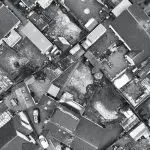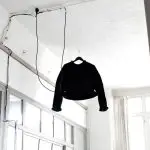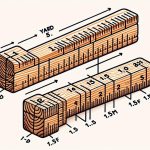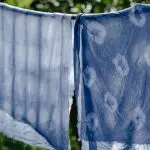When embarking on a crochet project, the question of 'How many yards of yarn will I need for a blanket?' can often feel like a puzzling enigma. The calculation involves more than just blanket dimensions; variables like stitch complexity and yarn weight play pivotal roles in determining the right amount of yarn to ensure a successful finish.
As we explore the intricate dance between yarn length and crochet projects, we'll uncover key insights that could save you from unraveling a half-done creation.
Table of Contents
Key Takeaways
- Yarn quantity varies by blanket size and stitch type.
- Factors like stitch complexity and tension affect yarn consumption.
- Use efficient techniques like lace stitches and single colors.
- Prevent shortages by calculating accurately and tracking progress.
Yarn Quantity for Different Blanket Sizes
Determining the amount of yarn needed for crocheting a blanket depends on the size you intend to create. For baby blankets, which are generally smaller, you'd typically require around 34 balls of worsted weight yarn.
If you're aiming to make a small blanket, approximately 68 balls of yarn might be needed. Moving up in size, a twin size blanket could consume around 151-7 balls of worsted weight yarn.
For a double bed-sized blanket, you may need about 232-5 balls of yarn. Lastly, if you're thinking about crocheting a king-size bed blanket, be prepared to use up to 303-4 balls of yarn.
It's essential to consider the stitches per inch, yarn weight, and the specific blanket pattern you'll be following to ensure you have enough yarn for your project. Selecting the right yarn weight, such as worsted or super bulky yarn, and matching it with an appropriate crochet hook will also play a significant role in determining the final yardage needed for your blanket.
Determining Yarn Needs Based on Stitch Type
When choosing the right yarn for crocheting a blanket, understanding how different stitch types impact yardage is key.
Dense stitches like single crochet will devour more yarn compared to lacy stitches such as the shell stitch.
Elaborate 3D stitches like popcorn or bobbles will also require a greater yarn investment due to their textured nature.
Stitch Type Affects Yardage
Using dense stitches like the moss stitch or basketweave will result in a higher yarn consumption due to their compact nature. Conversely, holey stitches such as the granny square or lace stitches use less yarn as they create open spaces. Elaborate 3D stitches like puff or bobble stitches can quickly consume yarn due to their intricate design. Tension also plays a crucial role in yarn usage, with tight crochet using more yarn compared to loose crochet. By choosing stitch patterns wisely, crocheters can optimize yarn usage and determine the amount needed for a specific blanket size.
| Stitch Type | Yarn Usage |
|---|---|
| Moss Stitch | High |
| Granny Square | Low |
| Puff Stitch | High |
| Lace Stitch | Low |
Choose Yarn Accordingly
Considering the stitch type you'll be using is essential when determining the amount of yarn needed for crocheting a blanket. When selecting yarn for your blanket project, keep these factors in mind:
- Stitch Weight: Dense stitches like double crochet can consume more yarn due to their tight structure.
- Hole Size: Stitches like the V-stitch or lace patterns may use less yarn as they create open spaces.
- Complexity: Elaborate 3D stitches such as popcorn or bobble stitches can use yarn faster due to their bulky nature.
- Tension: Tension in your crochet affects yarn consumption, with tight crochet using more yarn compared to loose crochet.
Factoring in Tension for Yarn Calculation
Factoring tension into your yarn calculations for crocheting a blanket is crucial for ensuring an accurate estimation of the yarn needed. Crochet tension, whether tight or loose, has a direct impact on yarn usage. Tight crochet tension tends to consume more yarn compared to a looser tension. To control yarn quantity and ensure accurate yarn calculations, it's essential to maintain a consistent tension throughout your project. Adapting your tension according to the pattern requirements can help you manage yarn consumption effectively. Understanding how tension influences yarn usage is key to planning your yarn quantities accurately. By being mindful of your crochet tension and its effect on yarn consumption, you can avoid running out of yarn or having excessive leftovers. Below is a table summarizing the relationship between crochet tension and yarn usage:
| Crochet Tension | Impact on Yarn Usage |
|---|---|
| Tight | Higher consumption |
| Loose | Lower consumption |
Managing Yarn Yardage With Color Changes
To efficiently manage yarn yardage when incorporating color changes in crochet blankets, it's essential to strategize the placement of colors to minimize waste and optimize overall usage. Here are four key strategies to consider:
- Plan Color Transitions: Think ahead and map out where each color change will occur to reduce leftover yarn ends and make the transitions seamless.
- Use Solid Colors Wisely: Incorporating solid colors strategically can help minimize the impact of frequent color changes on overall yarn quantity needed for the project.
- Opt for Limited Color Palettes: Limiting the number of colors in your design can streamline the color changes, reducing potential waste and simplifying the overall yarn management process.
- Integrate Color Changes into Design Elements: By weaving color changes into specific design elements or motifs, you can control yarn usage more effectively, creating visually appealing patterns while optimizing yarn yardage.
Impact of Yarn Weight on Quantity Required
Understanding how yarn weight impacts the quantity required for a crochet blanket is crucial for accurate project planning and yarn management. Yarn weight categories, such as bulky yarns and lightweight yarns, play a significant role in estimating yarn quantity for a blanket project. Bulky yarns (Yarn Weight 5) have a lower yardage per ounce compared to lighter yarn weights like Lace (Yarn Weight 1), meaning they require fewer yards to crochet a blanket of the same size. To illustrate this point further, let's compare the yardage per ounce of bulky and lightweight yarns in the table below:
| Yarn Weight Category | Yardage per Ounce |
|---|---|
| Bulky (Yarn Weight 5) | Requires less yardage |
| Lightweight (Yarn Weight 1) | Requires more yardage |
Understanding these differences in yardage requirements based on yarn weight will help crocheters accurately estimate the amount of yarn needed for their projects, ensuring they have enough yarn to complete their beautiful blanket creations.
Maximizing Yarn Efficiency in Crochet Projects
When aiming to make the most out of my yarn in crochet projects, I prioritize choosing lace stitches or panels, turning stash yarn into granny square centers, and sticking to a single color scheme to minimize waste.
Additionally, opting for a larger hook size and buying yarn gradually or in packs for discounts are tactics I employ to stretch my yarn further and save costs.
Yarn Selection Tips
Considering different crochet techniques and yarn management strategies can significantly impact the efficiency of your crochet projects. Here are some tips to help you maximize yarn efficiency:
- Utilize Lace Stitches:
- Incorporating lace stitches or panels can help you achieve a delicate and intricate look while using less yarn per square inch.
- Granny Square Centers:
- Transform your yarn stash into granny square centers to make the most out of your existing yarn collection.
- Single Color Projects:
- Opting for working with a single color not only simplifies calculations but also reduces yarn waste.
- Larger Hook Size:
- Using a larger hook size can help you crochet faster and use less yarn overall, making your projects more efficient.
Project Size Considerations
To get the most out of your yarn and create a cost-effective crochet project, it's crucial to carefully consider the size of your blanket before starting. Maximizing yarn efficiency is key in any project. Utilizing lace stitches or panels can help stretch your yarn further, while turning your stash into granny square centers is a smart way to use up leftover yarn effectively.
Choosing to work with a single color in your blanket reduces yarn waste and boosts efficiency. Additionally, using a larger hook size not only helps you crochet faster but also uses less yarn. For cost savings, consider purchasing yarn packs for discounts or shopping end of lot sales when planning your blanket project.
Stash Utilization Strategies
Leveraging different crochet techniques can significantly enhance yarn efficiency in your projects. To maximize yarn usage and reduce waste, consider implementing the following strategies:
- Use lace stitches or panels: Incorporating lace patterns can help stretch your yarn further while adding beautiful details to your project.
- Turn yarn stash into granny square centers: Transform leftover yarn into granny square centers to make the most out of your existing resources.
- Opt for a single color: Working with one color reduces the number of yarn ends and leftovers, promoting efficient yarn utilization.
- Try a larger hook: Using a larger hook size can create a looser fabric, requiring less yarn overall for your crochet projects.
Avoiding Excess or Insufficient Yarn Supply
To prevent running out of yarn or having excess leftover, it's essential to accurately calculate the total yards needed for your crocheting project. When planning for a baby blanket, consider the number of crochet stitches, make a gauge swatch, and use a yarn calculator or the pattern's guidance to determine the exact yards of yarn needed.
It's wise to purchase an extra skein or two to avoid running out of yarn unexpectedly. Ensuring accurate yarn usage is crucial to prevent any shortage or surplus.
Measure your gauge meticulously to match the pattern's requirements and keep track of your progress to adjust for any deviations from the estimated yardage. By following these steps and staying attentive to your yarn supply, you can confidently crochet your baby blanket without the worry of running out of yarn or having excessive leftovers.
Yarn Calculation for Worsted Weight Projects
When tackling worsted weight projects, ensuring you calculate the right amount of yarn is crucial for successfully completing your blanket. Here are some key factors to consider when estimating yarn consumption:
- Size Matters: For a large blanket, aim for approximately 2,500 to 3,500 yards of worsted weight yarn.
- Pattern Precision: Take into account the stitch pattern you plan to use, as intricate designs may require more yarn.
- Hook & Tension: Your hook size and tension play a significant role in determining the amount of yarn needed for your project.
- Stitch Density: Consider how tightly or loosely you crochet; stitch density impacts yarn usage.
Yarn Estimation for Bulky Weight Projects
When estimating yarn requirements for bulky weight crochet projects, it's essential to consider the thickness of the yarn and the desired blanket size. Bulky yarn, as the name suggests, is heavier than lightweight yarns, which impacts the yardage per ounce. Due to their thickness, bulky yarns typically require less yarn compared to lighter weight options. This means that for a chunky blanket, using bulky yarn can result in quicker progress and a cozy outcome.
For a double bed-sized project, you might estimate needing around 2,325 balls of bulky yarn. Remember to factor in the weight of the yarn when estimating the amount needed for your crochet project. By choosing bulky yarn, you not only achieve a quicker finish but also create a warm and inviting blanket perfect for snuggling up on cold nights.
Yarn Allocation for Super Bulky Projects
Switching from estimating yarn for bulky weight projects to super bulky projects, I've found that super bulky yarn typically requires varying amounts depending on the blanket's size and stitch pattern.
When working with super bulky yarn for a crochet project, it's essential to consider the following:
- Small Blankets: Super bulky yarn usually needs around 100-140 yards for a small blanket.
- Medium Blankets: For a medium-sized blanket, you may require approximately 140-200 yards of super bulky yarn.
- Large Blankets: Larger super bulky blankets can consume 200-300 yards of yarn due to their size.
- Considerations: The exact yardage depends on the blanket's dimensions and the stitch pattern used. It's advisable to purchase extra yarn to ensure you have enough for your super bulky crochet project.
Yarn Assessment for Fingering/Sport Weight Items
Exploring the world of fingering and sport weight yarns opens up a realm of possibilities for creating lightweight blankets with intricate details. When delving into projects using these yarn weights, it's essential to consider the yardage each weight provides.
Fingering weight yarn typically offers 350-450 yards per 100 grams, while sport weight yarn usually contains 250-325 yards per 100 grams. To determine the total yardage needed for your blanket, calculate based on the weight of the yarn you choose. For precise measurements, it's advisable to utilize a yarn calculator to ascertain the exact amount required.
These yarn weights are ideal for crafting delicate and detailed blankets that are perfect for adding a touch of elegance to your space. So, next time you're planning a project, don't forget to consider the weight of the yarn to ensure you choose the right amount for your lightweight masterpiece.
Frequently Asked Questions
How Much Yarn Is Needed to Crochet a Blanket?
Crocheting a blanket requires calculating the yarn needed based on size, stitch, and hook size. It's crucial to consider these factors to ensure I have enough yarn for a project that suits my desired specifications.
How Much Yarn Do I Need for a 50×60 Blanket?
Calculating yarn needs for a 50×60 blanket involves stitch, hook size, and tension. It's crucial to consider yarn weight, color changes, and gauge for an accurate estimate. I recommend buying slightly more yarn than calculated for ample supply.
What Can I Crochet With 400 Yards of Yarn?
With 400 yards of yarn, I can create various projects like hats, scarves, cowls, mittens, fingerless gloves, shawls, wraps, amigurumi toys, stuffed animals, dishcloths, coasters, and home decor items. The possibilities are endless!
What Can You Crochet With 1000 Yards?
With 1000 yards of yarn, the possibilities are endless! From intricate lace shawls to cozy oversized blankets, I can create masterpieces. The key is to be creative, experiment with different stitches, and let imagination soar!
- Fabrics and Their Role in Wellness and Comfort - July 26, 2024
- Choosing Safe Fabrics for Baby Clothes - July 26, 2024
- Impact of Fabrics on Skin Health - July 26, 2024








